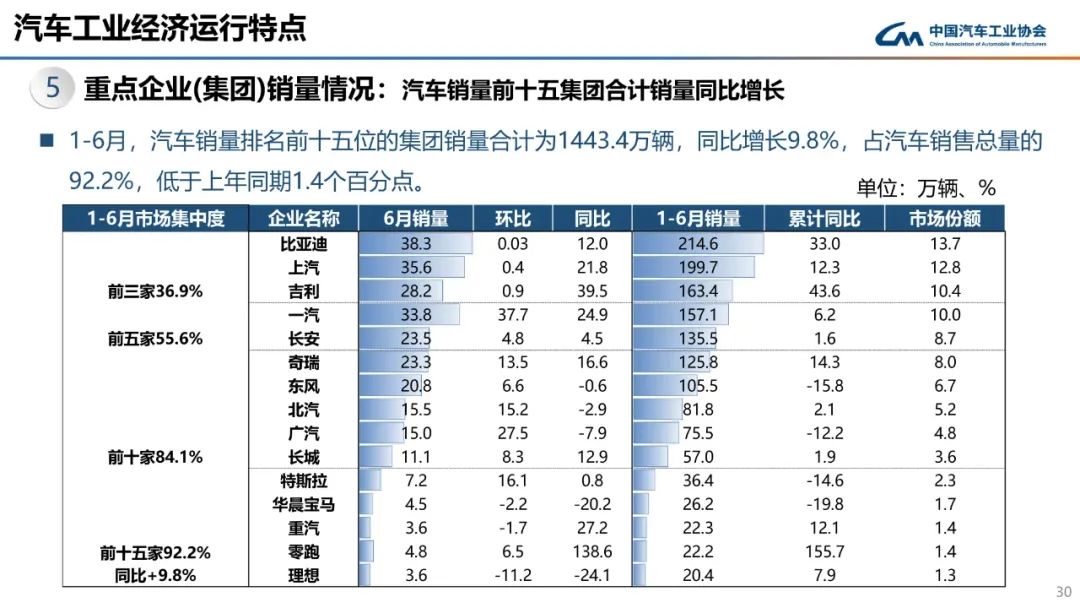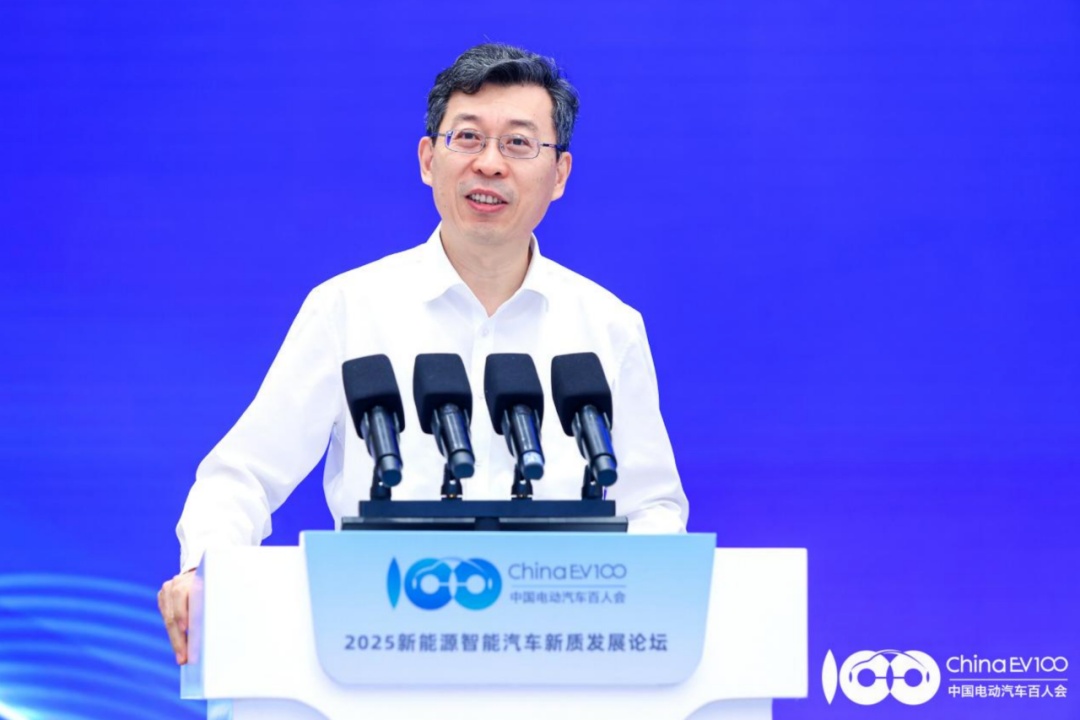China's Auto Market Hits All-Time High in Market Share for New Energy Vehicles
![]() 07/30 2025
07/30 2025
![]() 517
517
In the first half of 2025, China's automobile production and sales both surpassed the 15 million mark for the first time.
According to data from the China Association of Automobile Manufacturers, China's automobile production and sales reached 15.621 million and 15.653 million units, respectively, in the first half of this year, marking year-on-year increases of 12.5% and 11.4%. Among these, domestic sales of traditional fuel passenger vehicles amounted to 5.426 million units, down 1.8% year-on-year, whereas domestic sales of new energy passenger vehicles soared to 5.524 million units, up 34.3% year-on-year. Notably, domestic sales of new energy passenger vehicles have surpassed those of fuel vehicles.
Despite the overall growth in automotive production and sales, profits have not seen substantial improvement. Cui Dongshu, Secretary-General of the China Passenger Car Association, revealed that the automotive industry's profit from January to May 2025 stood at 178.1 billion yuan, a year-on-year decrease of 11.9%. The profit rate of the automotive industry was 4.3%, lower than the average profit rate of 5.7% for downstream industrial enterprises, though it did improve from the 4.1% profit rate recorded from January to April.
With the market scale reaching new heights, how can China's automobile industry achieve better development?
Behind the New Highs in Production and Sales

Chart source: China Association of Automobile Manufacturers
Currently, the automobile market exhibits high sales concentration, showcasing a "Matthew Effect" where the strong become stronger. Data from the China Association of Automobile Manufacturers shows that in the first half of this year, the combined sales of the top 15 automotive groups totaled 14.434 million units, accounting for 92.2% of total sales. Among them, BYD, SAIC, Geely, FAW, and Changan ranked in the top five. The new energy vehicle market is even more concentrated, with the top 15 groups accounting for a combined sales volume of 6.599 million units, or 95.1% of the total.
BYD, ranking first, sold a cumulative of 2.146 million units in the first half of the year, up 33.04% year-on-year. Its overseas market performance was particularly impressive, with cumulative overseas sales reaching 470,000 units, surpassing the overseas sales of 417,200 units for the entire year of 2024.
Data indicates that the market share of Chinese brand passenger vehicles has reached 68.5%, an increase of 6.6 percentage points year-on-year, marking an all-time high. In contrast, the market share of German brands has dropped to 13.1%, Japanese brands have fallen to 9.6%, and American and Korean brands combined account for only 7.6%. The discourse power of foreign brands in the Chinese market continues to weaken.
However, despite the decline in market share of Japanese automotive brands, Chinese automakers still lag significantly behind Toyota in terms of profitability. According to previously released data, in 2024, Toyota's net profit alone far exceeded the combined total of all Chinese automakers.
Huang Qifan, Executive Vice Chairman of the Academic Committee of the China Council for National Strategy and Development and former mayor of Chongqing, recently stated at the 2025 Beike Finance Annual Conference that China's automobile manufacturing is theoretically relatively efficient among manufacturing industries. However, as of June this year, the output value profit rate was only 5%, and the profit from 30 million vehicles was lower than that of Toyota's 9 million vehicles.
Toyota's financial report for fiscal year 2025 (April 2024 to March 2025), released on May 8, revealed a net profit of 4.765 trillion yen (approximately 230.526 billion yuan), more than double the total profit of domestically listed passenger vehicle companies.
In the first half of this year, Toyota sold 837,700 units in China. As of mid-July, the cumulative number of Toyota owners in the Chinese market exceeded 25 million. Lexus sold more than 85,000 units in six months, continuing to achieve positive growth in a market where both luxury vehicles and imported vehicles are declining, firmly occupying the top spot in imported luxury vehicle sales. In the "2025 First Half-Year China Automobile Value Retention Research Report" jointly released by the China Automobile Dealers Association and Jingzhen Gu, the overall three-year value retention rate of the Lexus brand reached 60.51%, ranking first among Japanese brands.
Not Just 'Sales Volume' but Also 'Quality'
Having achieved scale in 'quantity', how to achieve development in 'quality' is a pressing concern for the Chinese automobile industry.
The Chinese automobile market has nearly become the most fiercely competitive arena globally. Amidst this intense competition, most companies in the industry have been caught up in a "price war," and the "involutionary" competition has caused significant hardships for practitioners.
In May this year, relevant officials from the Ministry of Industry and Information Technology stated that they would intensify efforts to rectify the "involutionary" competition in the automotive industry. The State Council Executive Meeting held on July 16 clearly stated the need to focus on promoting the high-quality development of the new energy automobile industry, addressing various irrational competitive phenomena within it, adhering to a combination of short-term and long-term measures, and effectively regulating the competitive order of the new energy automobile industry.
He Xiaopeng, Chairman and CEO of Xpeng Motors, told China News Weekly, "The market competition now is not the fiercest; it will become more intense in one or two years of the next five years." In He Xiaopeng's view, "In the current competitive environment, we should not focus on price but on technology. We should expand beyond China and go global. At the same time, we should move towards new productive forces and embodied intelligence."
"We do not participate in the so-called 'price war' or involution. We need to improve our own efficiency, research and development, manufacturing, and quality," Lu Fang, CEO of Voyah Motors, told China News Weekly. "Voyah will definitely continue to adhere to long-term high-quality development in the future."
It is foreseeable that the focus of future competition in the automobile market will also shift to technological competition. Automakers are increasing investment in core areas such as battery endurance, intelligent driving, and in-car systems, ushering the industry into a new stage of "cost reduction and efficiency enhancement."

Image source: China Electric Vehicle Hundred Person Forum
At the 2025 New Energy Smart Automobile New Quality Development Forum, Zhang Yongwei, Vice Chairman and Secretary-General of the China Electric Vehicle Hundred Person Forum, bluntly stated that the global competition is currently centered on intelligence, and the penetration rate of L2-level assisted driving in China has exceeded 50%.
"We have indeed achieved lane-changing overtaking in electrification and terminal leadership in intelligence. The industrial ecology is becoming increasingly rich. How to consolidate and expand our development advantages in intelligence is now a very urgent issue for China's automobile industry. If we slow down, our past advantages may be surpassed by others," Zhang Yongwei mentioned that cost and intelligence are the top two factors for consumers when buying cars. Among them, the proportion of cost accounts for nearly 60%, while intelligence also accounts for 54% of the weight.
From a technological development perspective, intelligent driving is currently in a critical period of transition from L2 to L3. In Zhang Yongwei's view, the main task from now to 2030 is to accelerate the popularization of assisted driving. "It is necessary to quickly propose the development goals of L3 and higher-level autonomous driving. This is a challenging goal for intelligent driving, and it has now entered a stage of fierce research and development competition, although it has not yet been industrialized. The time window is not long." Zhang Yongwei believes that around 2030 should be the time window for L3 and L4 to transition from pilot to large-scale application. He suggested that automakers should grasp the development goals of different stages of intelligent driving in China, make good use of the time window, and maintain a fast pace.
Currently, the close integration of intelligent driving technology and complete vehicles is a significant feature of cutting-edge technological innovation in China's automobile industry. Zhang Yongwei said, "In the era of intelligence, the relationship between complete vehicles and components has entered a deep cooperation mode. For example, the technologies of companies such as Huawei, Momenta, and Yuanrong Qixing were bound to complete vehicle enterprises at the initial stage of research and development. This is a very gratifying phenomenon."
Reaching the top in production and sales scale is merely the first step. Achieving breakthroughs in profit levels, technological barriers, and brand premiums will determine whether China can truly become a global leader in the automotive industry. Amidst the dual transformations of electrification and intelligence, opportunities and challenges coexist. Only by continuously innovating and making up for shortcomings can we seize the initiative in this unprecedented great change.





